21 Ways To Make Your Narrow Hallway Look Wider
21 Ways To Make Your Narrow Hallway Look Wider
By Jack
4th Aug 2025
Struggling with a narrow hallway? These 21 clever design tricks will help make your hallway look wider, brighter and far more welcoming.
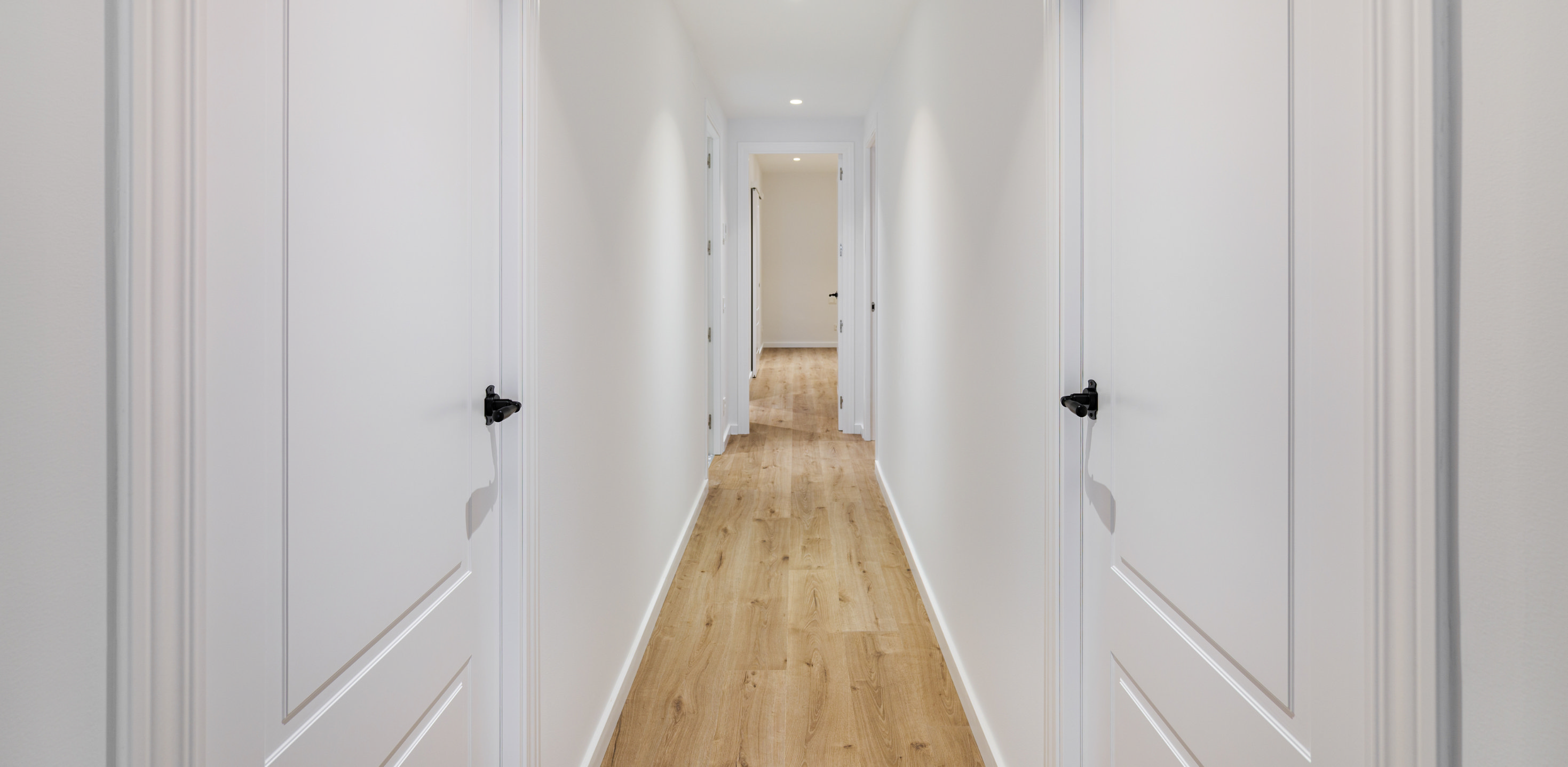
Is your hallway giving ‘bowling alley’ vibes? Fear not. Designers, architects and seasoned DIYers agree that the right blend of lighting layers, colour confidence, clever flooring and slim line storage can expand even the tightest space. Below, you’ll find 21 tried and tested strategies to make your narrow hallway look bigger.
We’ve split our 21 narrow hallway ideas into six bite size chapters so you can skip straight to the narrow hallway fixes that fit your home and budget:
How To Make A Narrow Hallway Look Wider With Light
1. Layer Your Lighting
Makes a hallway feel wider with even, overlapping light coverage . Instead of relying on a single ceiling bulb (which leaves side walls in shadow), use multiple light sources spaced along the length of the hall. For example, a series of useful spotlights or flush ceiling lights can be installed about 1 meter apart so that their beams overlap. If possible add wall sconces at eye level for additional horizontal illumination. This layered lighting prevents the eye from perceiving the true boundaries of the hallway, making the walls seem to fall away and the corridor appear broader. The key tip here is ensuring continuous, overlapping light across the ceiling and upper walls – it “pushes” the walls outward visually by removing tell-tale shadows.
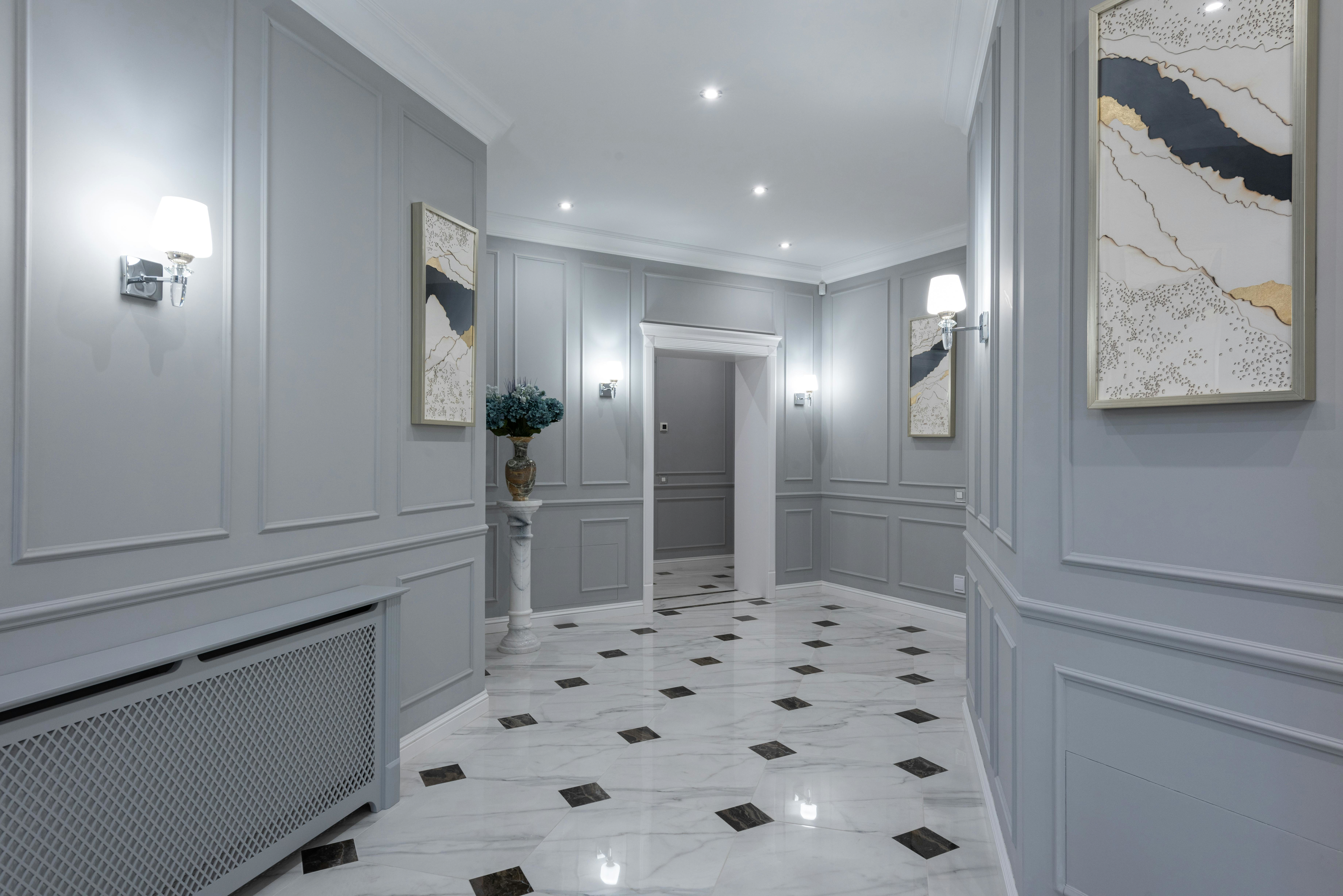
2. Borrow Daylight
Natural light is the cheapest hallway width amplifier. If possible, introduce daylight from multiple directions. This can be done by installing a clear or frosted glass panel in the front door, keeping transom windows (fanlights) above doors unobstructed, or even adding a tubular skylight in the ceiling. Sunlight streaming in from these openings travels the length of the corridor, making walls seem to “slide” apart. A brighter hall also draws the eye outward, reducing the tunnel effect. Even on cloudy days, a skylight or sun tunnel brings in consistent light, which makes a narrow, enclosed hall feel more connected to the outdoors and less like a closed-in tunnel
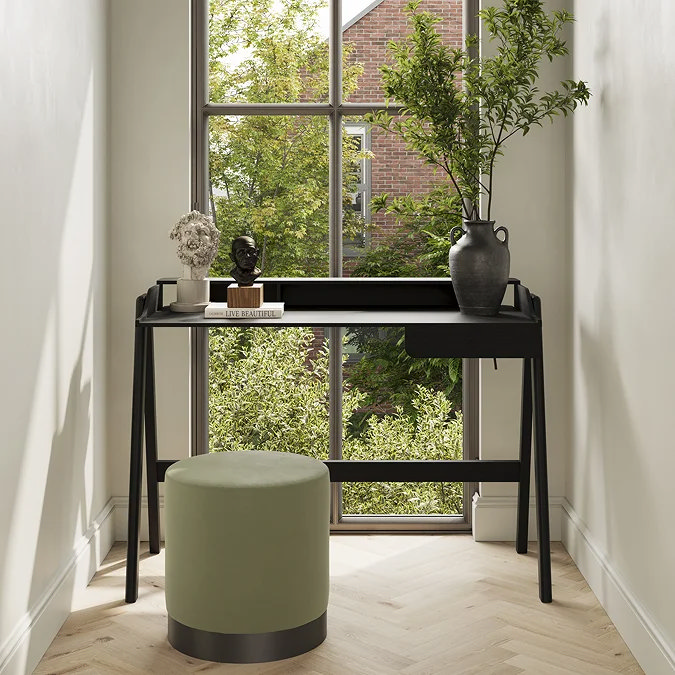
3. Mirror The Light
Mounting a tall, frameless mirror on the wall directly opposite a window or other bright light source effectively doubles the natural light in the hallway. This reflection fools the brain into perceiving a second window or opening, which visually widens the space. The mirror also adds depth – one sees the reflected hallway extending beyond the wall, an optical illusion that increases the sense of width. For best results, position the mirror so its bottom edge is just above the skirting board (baseboard), or simply lean a full-length mirror against the wall if drilling isn’t possible. The reflected light and imagery will soften corners and make the hallway seem almost twice as wide.
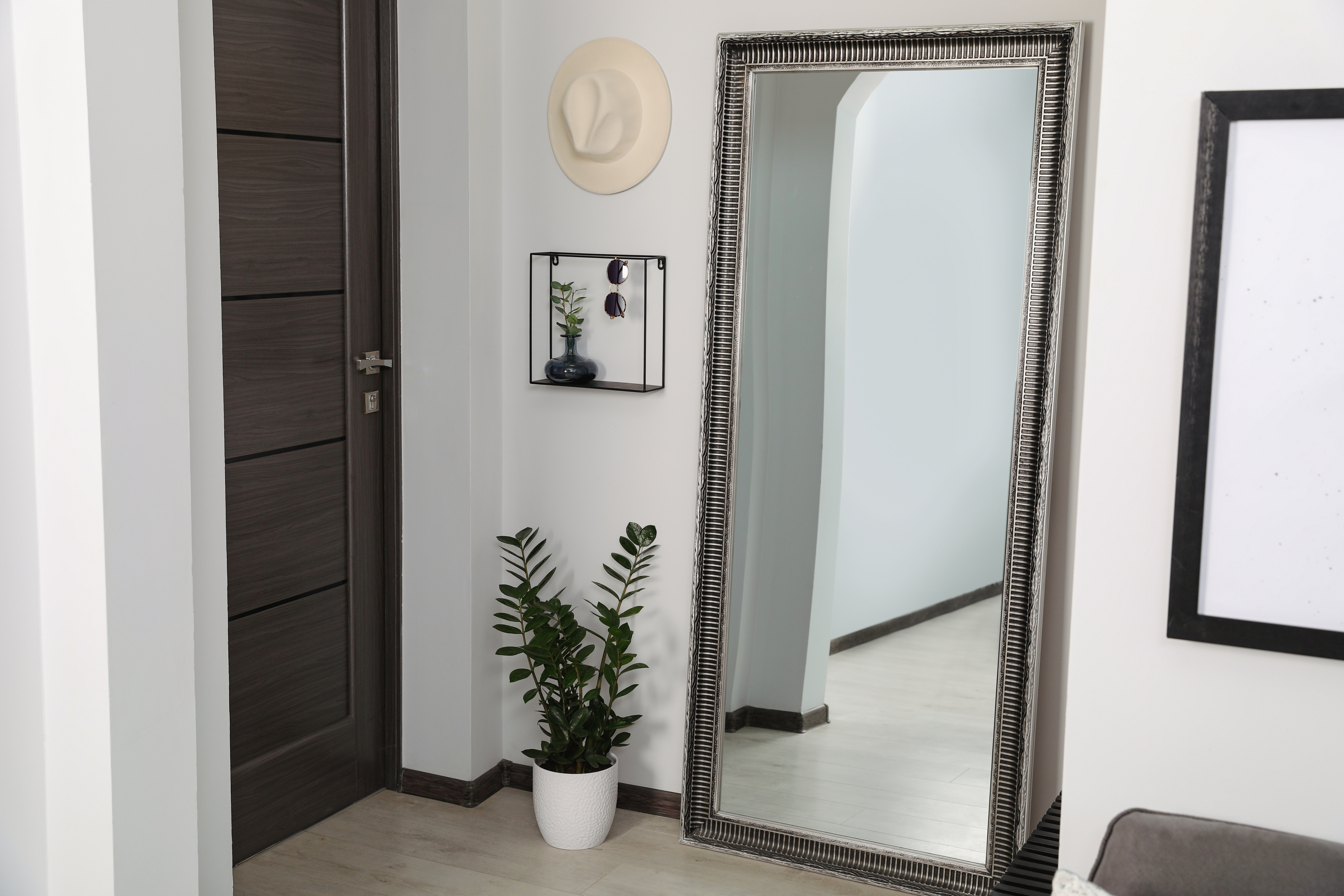
4. Install LED Wall Wash Strips
A subtle but powerful lighting trick for cramped halls is to use concealed LED strips along the upper walls. For instance, sticking flexible LED tape behind a simple crown moulding or a narrow ledge a few centimetres below the ceiling produces a continuous wash of light down the walls. This halo effect at night visually erases the corners where walls meet the ceiling. By disguising these edges, the hallway’s true boundaries become harder to discern, so it feels wider and taller.
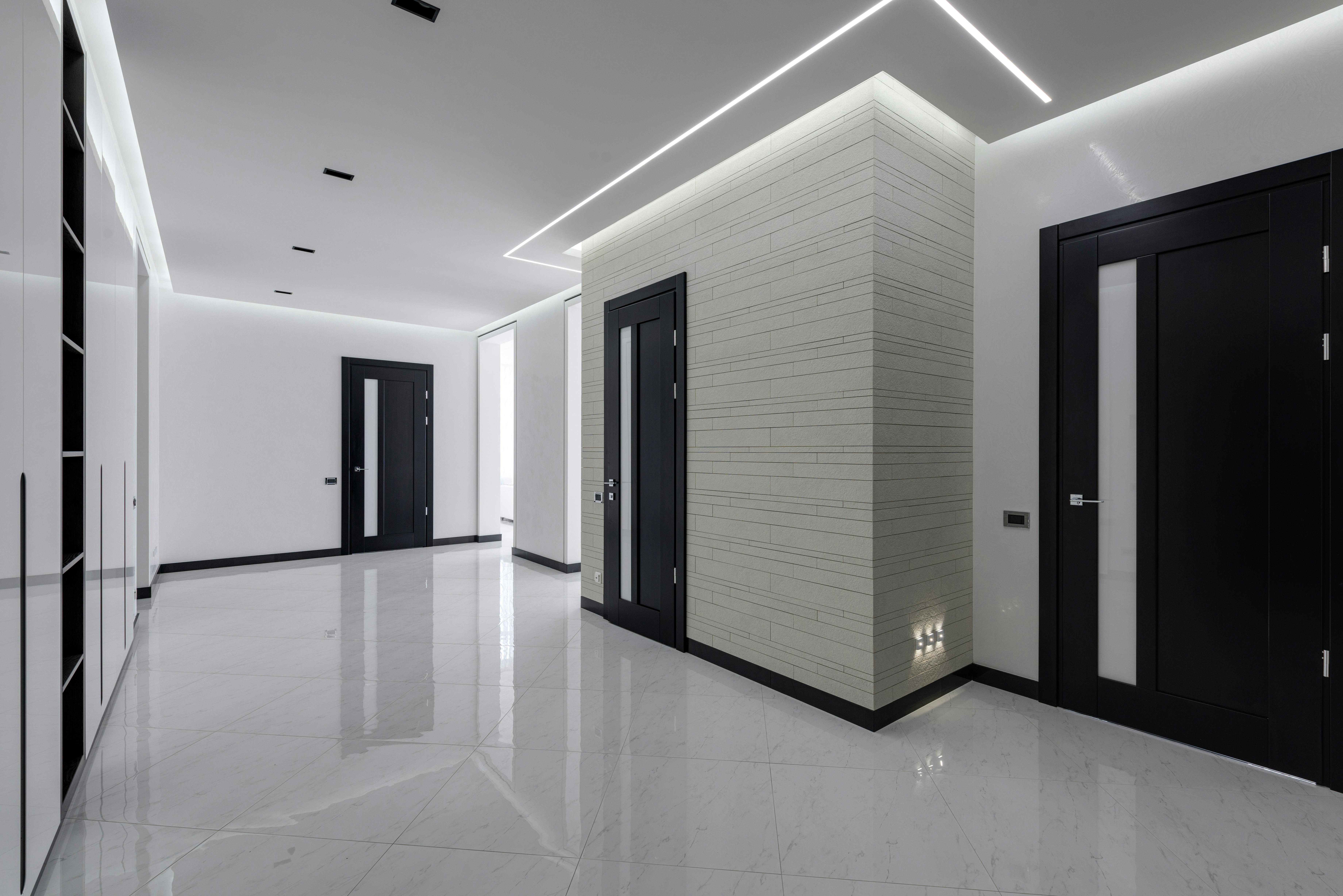
Paint Ideas To Make Your Hallway Look Wider
5. Two Tone Dado Paint Trick
In a narrow hallway, painting the walls in two tones can cleverly alter perceived proportions. The idea is to apply a darker colour up to about waist or dado rail height (approximately 90 cm or 3 feet from the floor) and a crisp lighter shade above that, continuing onto the ceiling. This strong horizontal division anchors the floor and visually raises the ceiling line. The dark lower band grounds the space, and the light upper walls and ceiling seem to “float” above it. As a result, the upper walls feel less constraining.
This classic two-tone treatment instantly widens the feel of the hall by drawing the eye to the light-filled upper area while the darker bottom half recedes. It’s a known optical trick: our eyes perceive the high-contrast boundary as the true width, effectively pushing the walls outward. Just be sure to choose a near white or very pale hue for the top section to maximize brightness, and a richer, grounding colour (like charcoal, olive, or navy) for the bottom section for contrast.
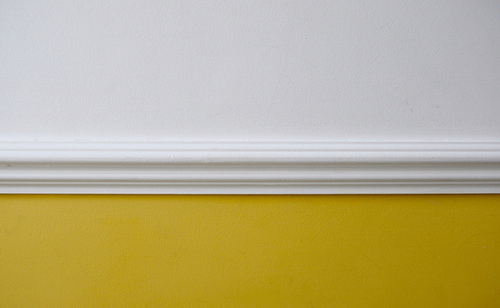
6. Accent The End Wall
Long, tunnel-like hallways can be optically shortened (and feel less narrow) by highlighting the short end wall in a contrasting, bold colon. This “feature wall” approach pulls the end wall forward visually. By doing so, the hallway appears shorter, and the two long side walls seem to spread apart in comparison. You can use any striking hue – such as a spicy red, deep teal, or sunny yellow – that contrasts with the corridor’s side walls. The side walls, meanwhile, should be kept neutral or lighter so they recede. In practice, when someone enters your hallway, their attention goes straight to the coloured end wall (or door), and the lack of strong colour on the long walls means those walls don’t draw attention to how close they are. It’s a simple focal point trick: shortening the hallway’s appearance ends up widening its feel.
7. Colour Drench Everything
If you’re feeling bold, paint the walls, trim, and even ceiling all the same colour. By removing contrast lines between different surfaces, you make it hard for the eye to distinguish where walls end and the ceiling begins - a technique known as “colour drenching.” The result is surprisingly dramatic yet expansive: the continuous colour blurs the edges of the room. Without the usual white ceiling or trim to outline the boundaries, the space reads as larger and more unified.
Colour drenching in medium to light tones can make a small hallway feel bigger because the eye isn’t stopping at colour breaks. In a hall, a single mid-tone (e.g. dusty blue, sage green, or warm grey) creates a cosy, tunnel-like vibe but also conceals the true width since corners and junctions are all the same shade. For those hesitant to go all-in on one colour, consider painting the ceiling slightly lighter or glossier version of the wall colour to maintain the effect with a bit of variation.
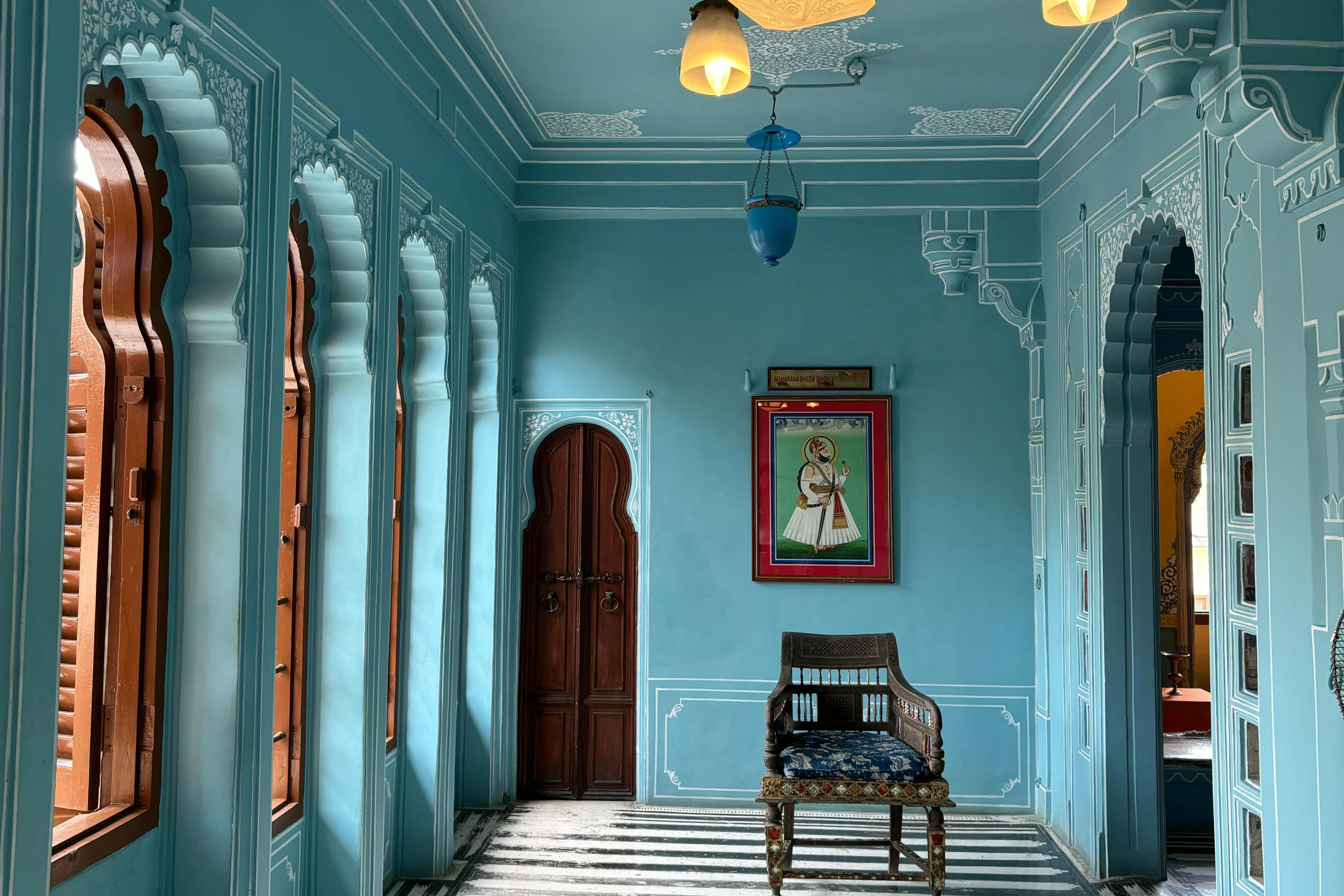
8. Choose Cool Hues That Recede And Widen
Widen your space visually with cool colours. For hallway side walls, consider light, cool-toned paints like misty aqua, gentle sage, or a soft blue grey. These hues make the walls seem to recede a little. In contrast, paint the ceiling a warm white or very light warm neutral to keep it feeling high and inviting. The combination of cool walls and a pale, warm-tinted ceiling makes the corridor feel broader but not cold. Designers often recommend icy blues or pale greens for narrow halls because muted cool tones create a calming and spacious atmosphere, especially when paired with white trim or ceiling. For example, a hallway with pale blue walls and a white ceiling will appear brighter and wider than one with darker, warmer walls. The warm white overhead prevents the space from looking too clinical or under lit, balancing the coolness of the walls.
Tip: test how your chosen cool colour looks in the hall’s lighting – it should be light-reflective and not too saturated for the best widening effect.
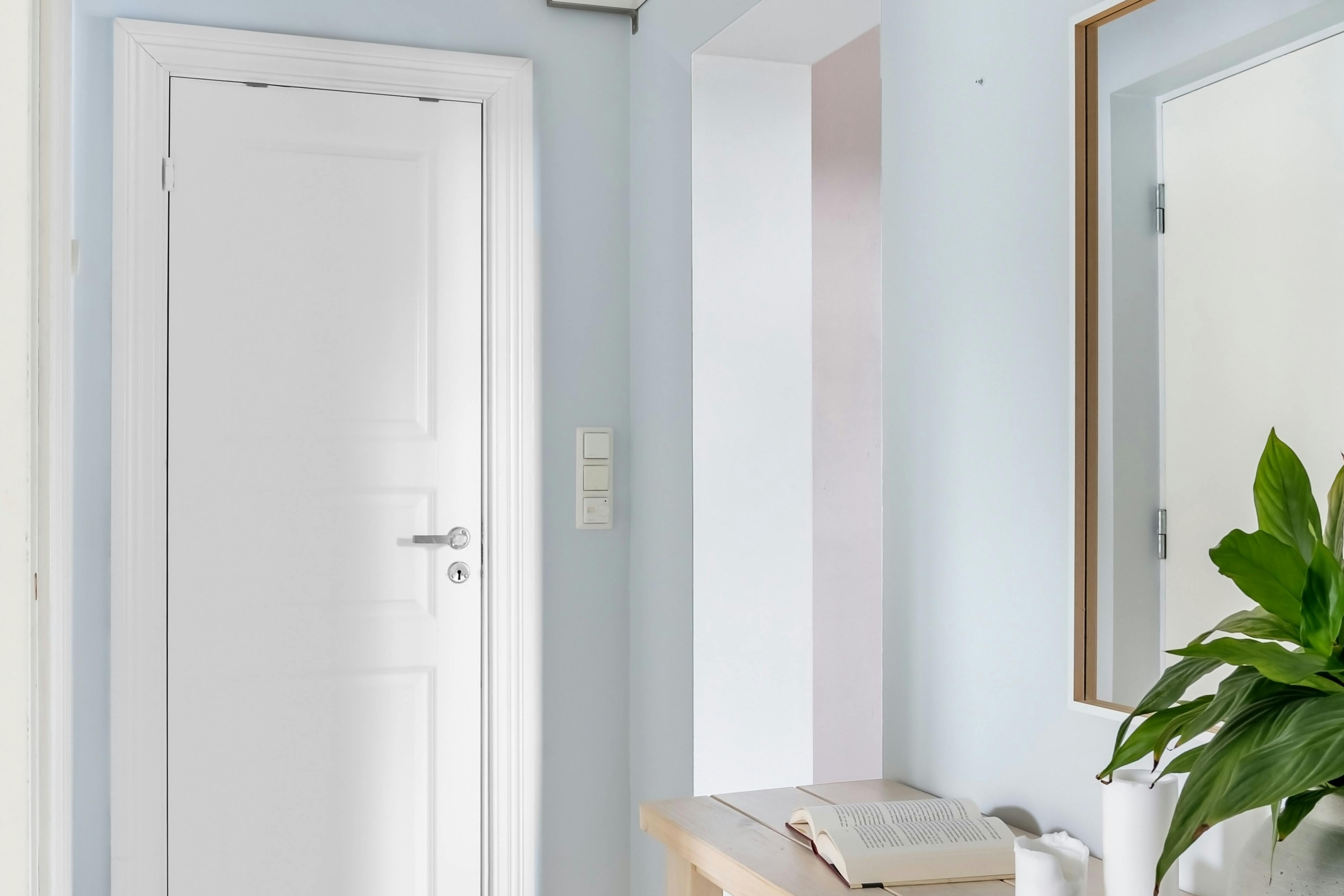
9. Paint Horizontal Stripes To Stretch The Corridor Sideways
Just as vertical stripes can make a ceiling look taller, horizontal stripes (whether painted or in wallpaper) can make a narrow hallway look wider. The alternating light and dark stripes draw the gaze side-to-side rather than down the length of the corridor. This works like a panoramic photo effect – the stripe pattern leads your eyes horizontally, effectively “stretching” the walls outward. When using this trick, keep the contrast gentle (e.g. tone-on-tone neutrals or pastels) so the effect isn’t too jarring. Low-contrast stripes will subtly widen the look without overwhelming the space.
If your hallway has a low ceiling and you need height more than width, you can flip this strategy: use narrow vertical stripes to make it seem taller instead. But for most long, skinny hallways, horizontal lines are ideal for visually breaking that bowling-alley feel. Even a striped runner rug or stripes on one accent wall can contribute to a wider perception, but wrapping stripes around all walls delivers the most uniform result.
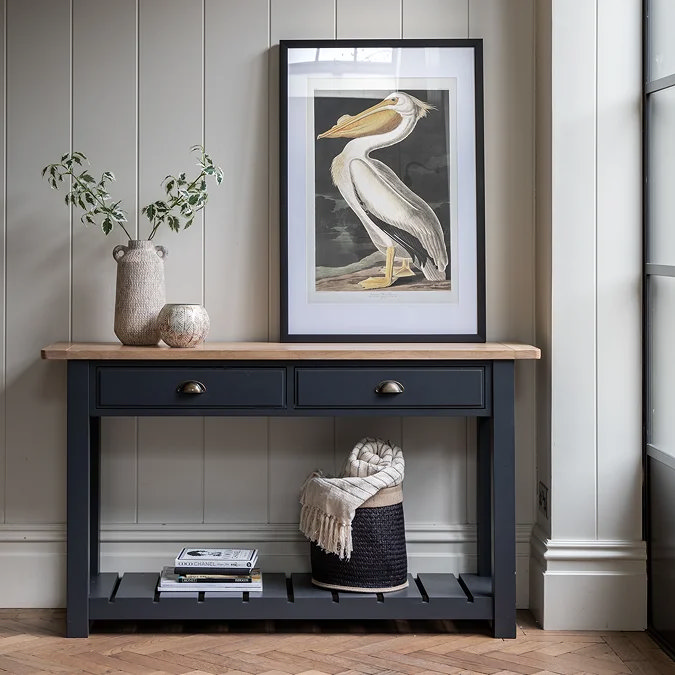
Flooring Tips for Making a Hallway Look Wider
10. Fit Large Format Tiles
Small floor tiles or busy patterns can reinforce a corridor’s narrowness by creating strong directional lines. Instead, using larger tiles (at least 30×60 cm, or ~12×24 inches) will reduce the number of grout lines cutting across the floor. Fewer visual breaks on the floor make the hallway feel longer and wider, because the uninterrupted floor expanse isn’t segmented. In fact, large format tiles are popular in entryways and hallways specifically because of their widening effect.
For example, a narrow foyer with 12″×24″ porcelain tiles laid in a staggered pattern will appear more expansive than the same space with many small tiles. If retiling isn’t an option, you can match the grout colour to your existing tile to make the joints less visible. A continuous looking floor tricks the eye into seeing a larger area. We recommend choosing a tile with a light or neutral tone if possible – brighter floors reflect more light, and a seamless light floor will push the walls outward visually. Not only does this approach enhance spaciousness, it also results in easier maintenance (fewer grout lines to clean!).
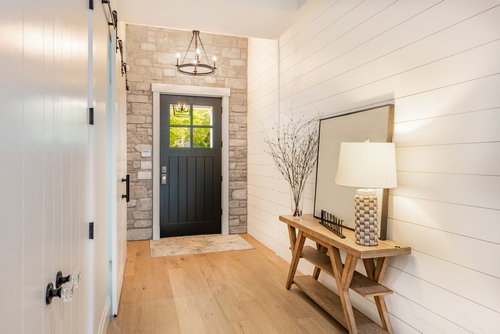
11. Frame The Floor With A Runner
If you use a hallway runner rug, don’t cover the full width of the hall – instead, choose a runner that is significantly narrower than the hallway so that ~15 cm of bare floor is visible along each side.
This exposed flooring acts like a frame, and that frame creates the impression of greater floor breadth. In other words, the hallway floor seems wider because you can see a margin of it beyond the rug’s edges.
This prevents the runner from looking like wall-to-wall carpeting and keeps the corridor from feeling cramped. If your hallway is also very long, you can opt for a runner with horizontal stripes or a pattern that runs across the width – this will visually shorten the length while still widening the feel. But regardless of pattern, centering a suitably narrow runner will trick the eye into “seeing” more floor area on the sides than truly exists.
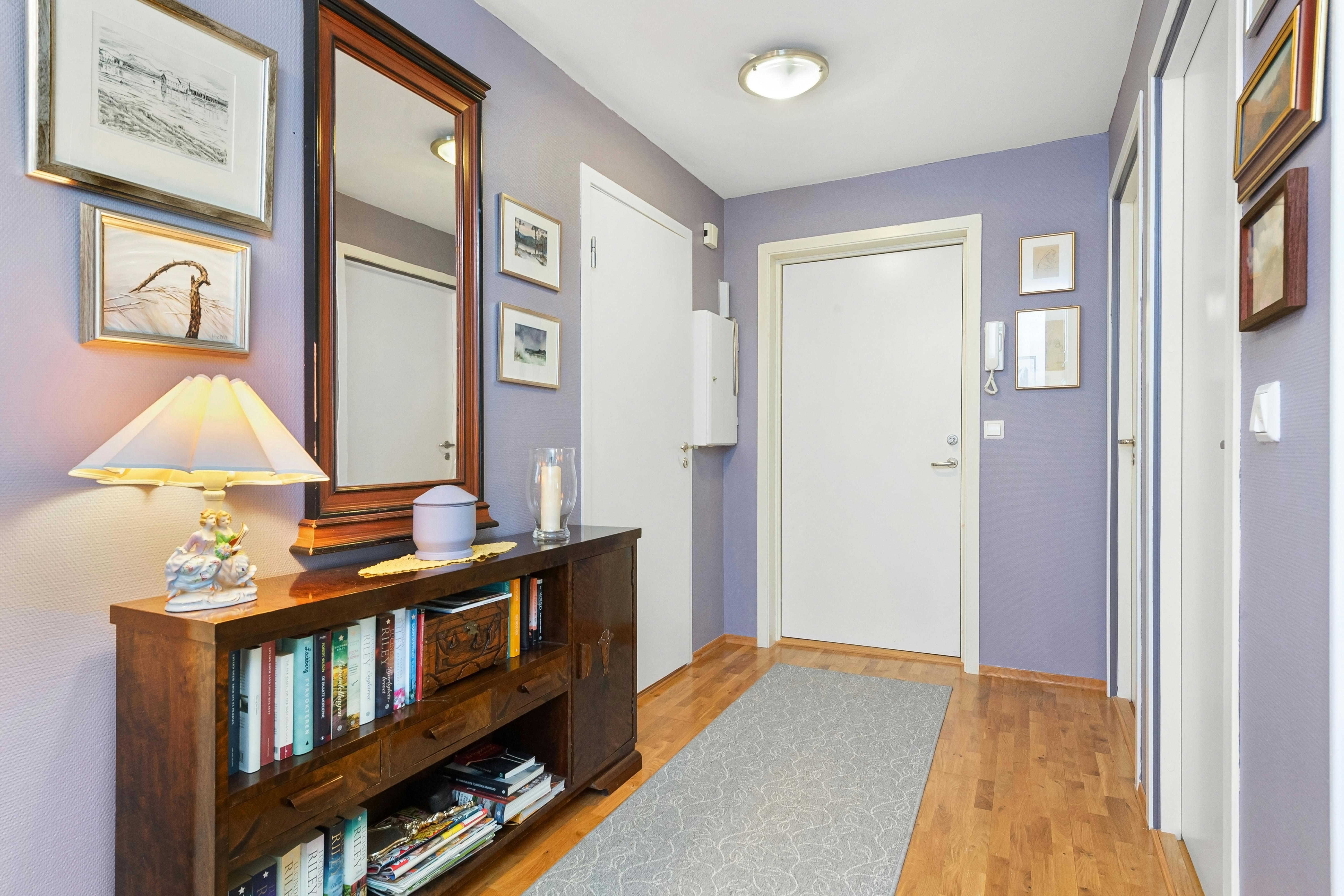
Storage Solutions That Make Your Small Hallway Look Wider
12. Declutter Ruthlessly
Often, hallways feel narrow simply because they are full of stuff – shoes, coats, boxes, plants, you name it. By removing all unnecessary items, you immediately restore the full walking width and openness of the corridor. Just “clearing the floor space” can have more effect on usability than any optical trick. Start by emptying the hall completely and only putting back the truly essential items (maybe a doormat and one piece of furniture). Everything else: seasonal gear, extra shoes, miscellaneous objects, should be stored elsewhere or donated. The goal is a clean, open pathway. Decluttering should always be step one, because a narrow hall with no clutter will always feel wider than a cluttered wide hall.
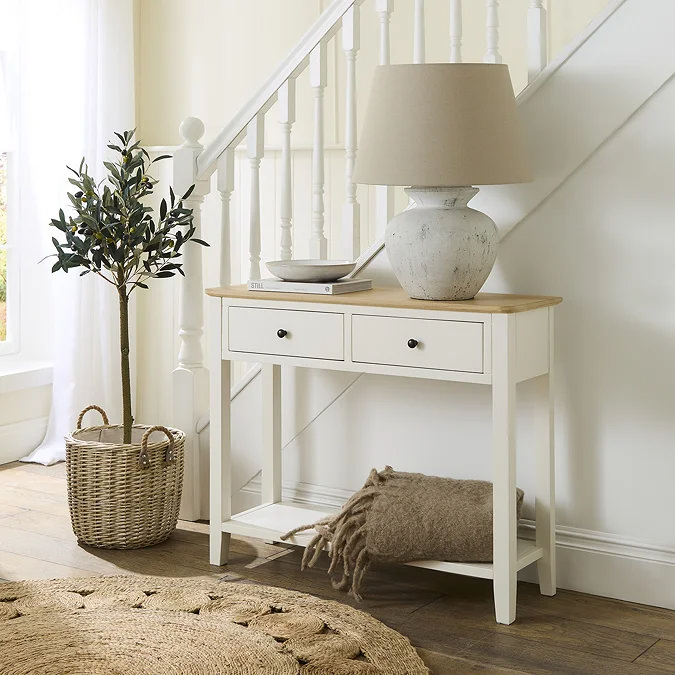
13. Keep Furniture To One Wall
If your hallway is narrow, any furniture (benches, consoles, coat racks, etc.) should be lined up along a single wall. The other side should remain clear to preserve an open walkway. This asymmetrical arrangement creates “breathing room” – one can walk down the hall without dodging obstacles on both sides. By contrast, if you place furniture on both walls in a tight corridor, you create a canyon effect that significantly reduces the perceived (and actual) width. We recommend keeping narrow halls as open as possible to prevent a hemmed-in feeling.
If you need storage, choose slimline pieces that hug the wall. As another pro tip, choose the furnishings that are roughly the same colour as the wall - helping them blend in and not chop up the visual space. Furnishing only one side of the hallway allows two people to pass if needed and maintains a clear line of sight, making the hall feel wider.
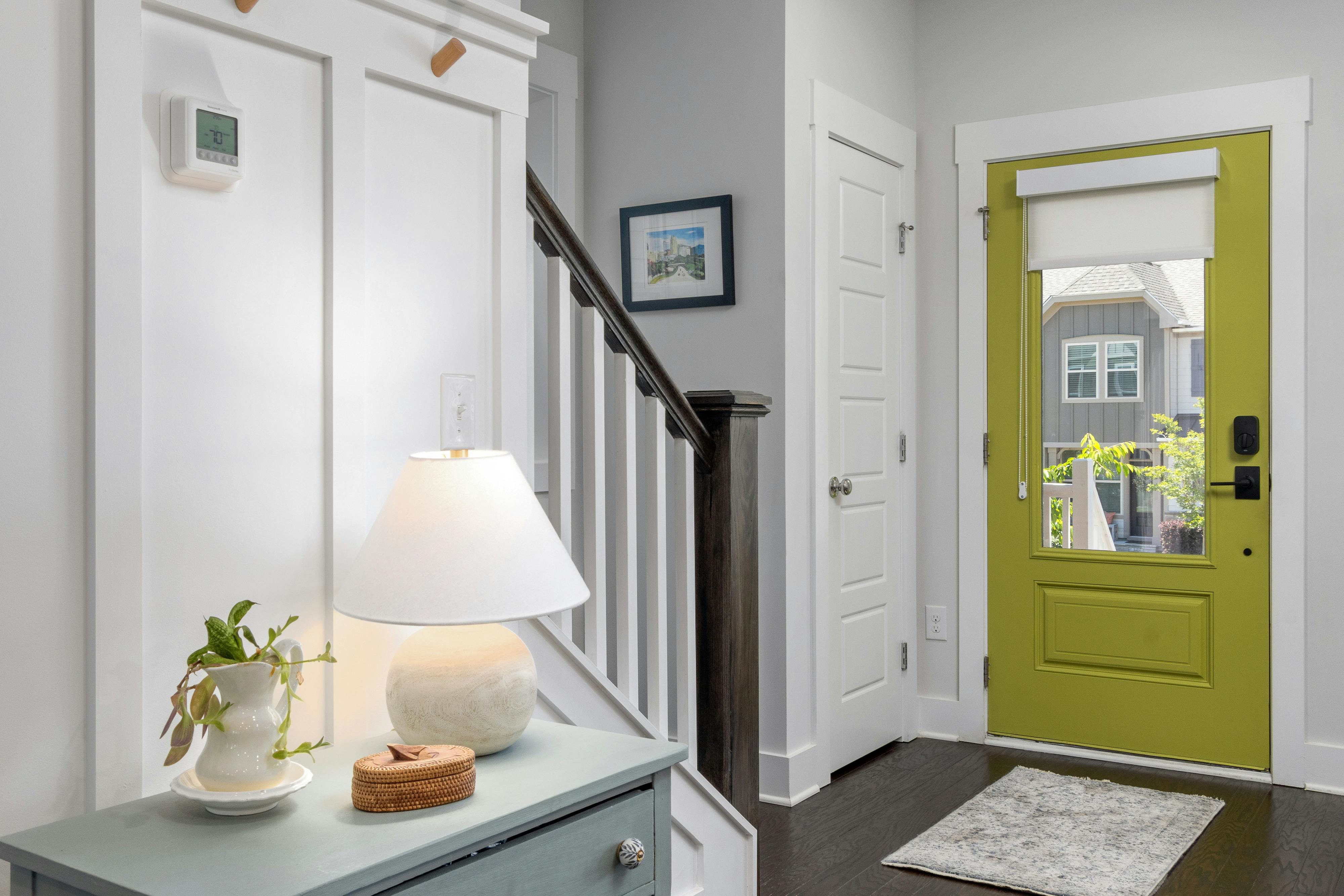
14. Install A Floating Console Shelf
In very tight quarters where even a narrow table on the floor might snag toes, opt for a floating shelf or console attached to the wall. Wall mounted consoles (whether a single shelf or a closed cabinet unit) provide a surface for keys, parcels, and décor without encroaching on legroom. When installing a floating shelf, ensure its anchored securely (since people might lean on it in a narrow hall) and position it around waist height for comfortable use. The uninterrupted floor beneath will signal more usable square footage, and the hallway will read wider than if a freestanding piece were placed there.
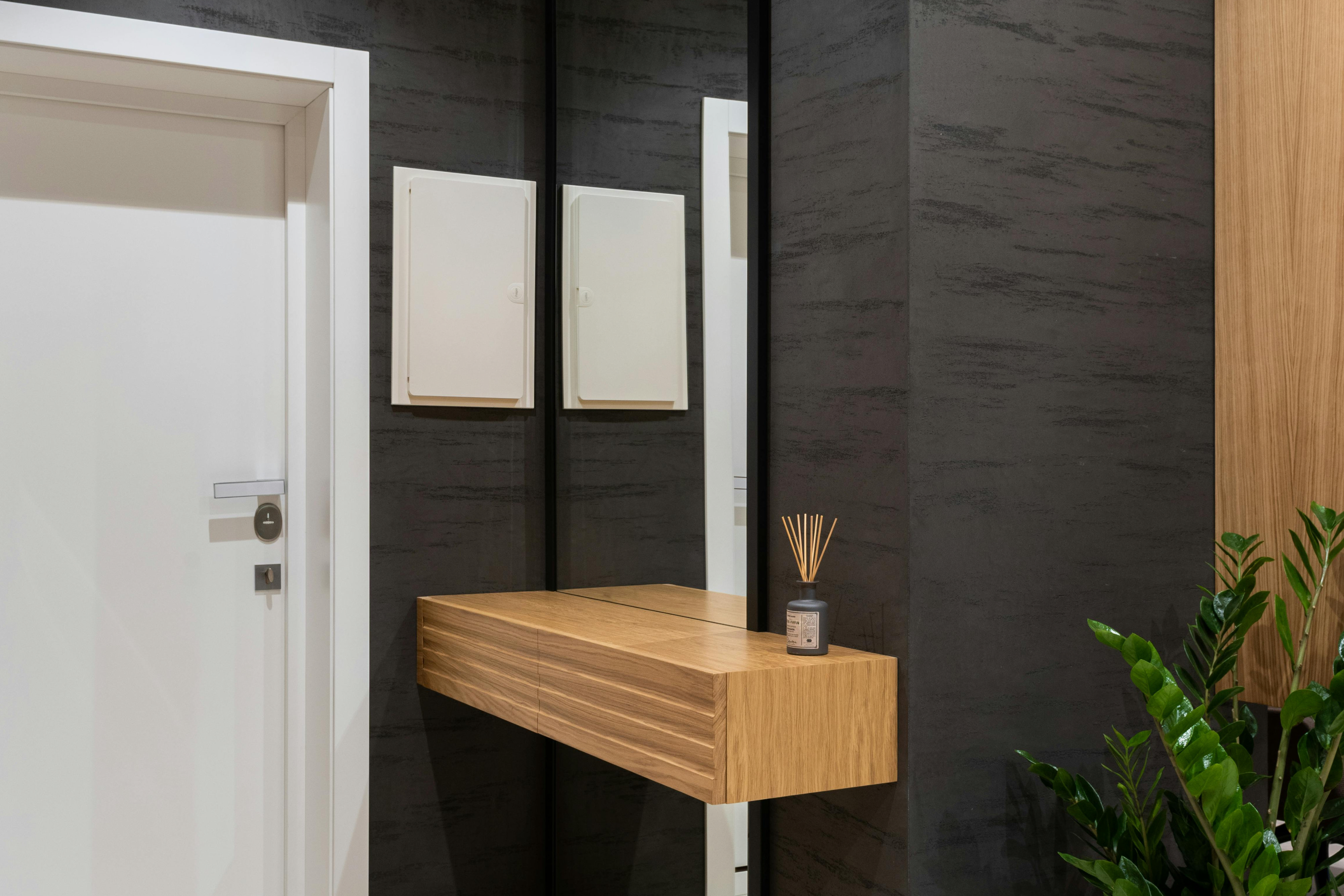
Wall Treatments That Make Hallways Appear Wider
15. Panel One Wall For Hallway Depth
A clever way to create a sense of depth and width in a hallway is to install vertical panelling (like tongue-and-groove boards or slim MDF battens) on just one of the long walls, then paint it the same colour as the wall. This textured treatment on one side introduces subtle shadow lines and visual interest, which distract the eye from the actual width. Because the panelling is monochromatic with the wall, it’s the texture (the grooves) that does the work, not colour. Those fine vertical lines tend to recede into the distance, making that wall seem farther away than the smooth wall opposite. Essentially, the panelled wall “moves out” visually, allowing the plain wall across from it to breathe. This trick works especially well if you choose a light, reflective paint for the panelling – the grooves create delicate shadows that add depth, while the light colour keeps the space bright.
By panelling one side only, you avoid crowding the hallway, and you balance texture with open space. The result is a hallway that feels more dimensional and a bit wider. (Plus, panelling protects that wall from scuffs, serving a practical purpose in tight passages.)
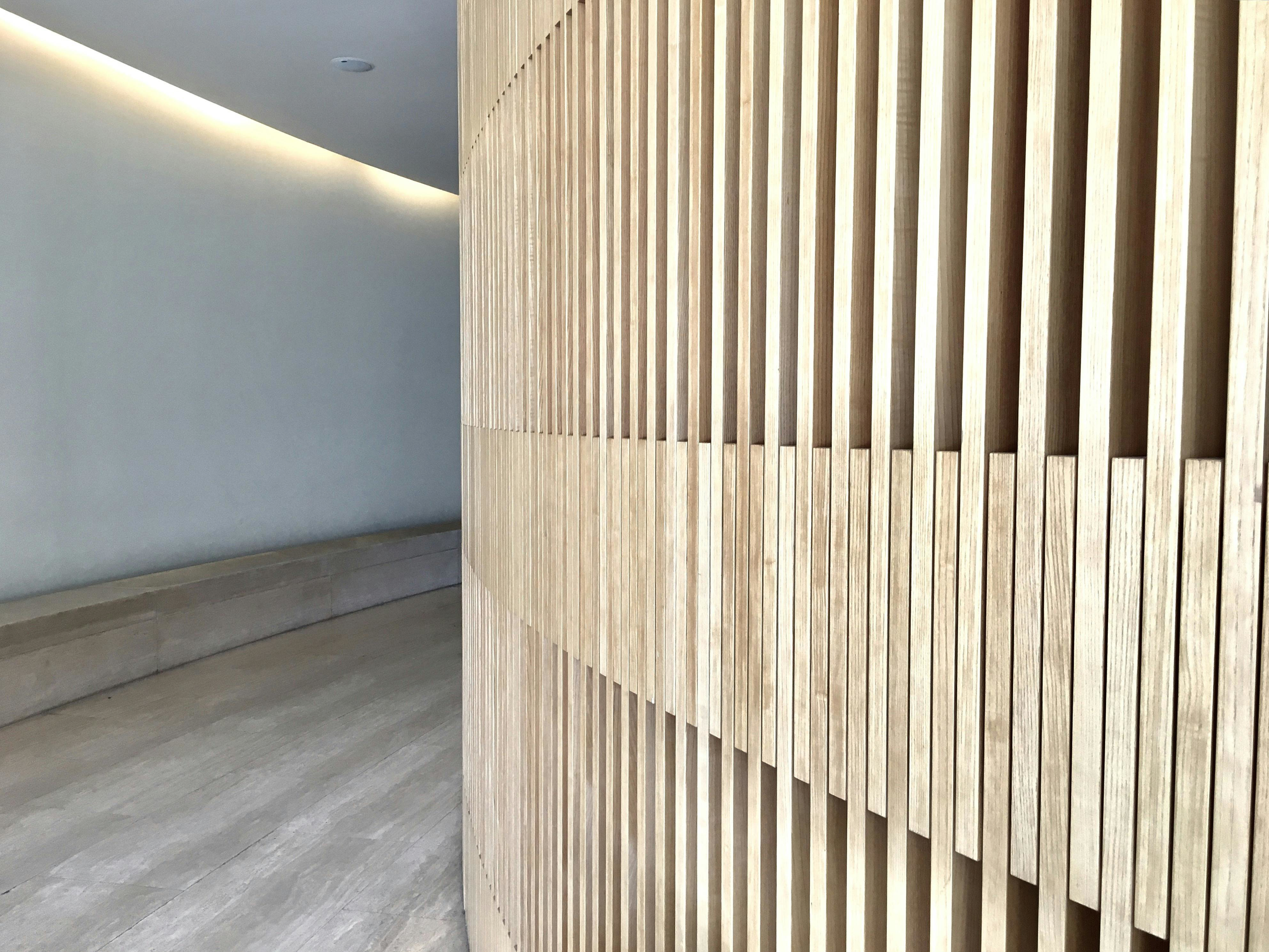
16. Apply Grasscloth Below The Dado
For fans of natural materials, consider installing grasscloth wallpaper or another textured wallcovering on the lower portion of your hallway walls (below a dado rail or chair rail height), with a smooth, light paint above. The tactile, horizontal weave of grasscloth draws the eye along the length of the hallway, emphasising its extension while the plain upper walls keep things bright. This treatment essentially combines a texture with the two-tone method: the textured bottom half grounds the space and adds interest, leading one’s gaze forward through the hall, whereas the untextured top half in a light colour maintains an open feel. The contrast in texture, rough below, smooth above, can make the corridor feel wider because the busy pattern is kept low (at eye level and above everything is calm and light).
The natural fibres will reflect light in tiny ways and add depth. Visitors will subconsciously perceive the hallway as more interesting and not just a narrow tunnel, all without the grasscloth encroaching on space (since it’s flat on the wall). It’s an elegant way to add character and a sense of breadth simultaneously.
17. Use White Wainscoting To Bounce Light And Widen A Dark Hall
Bright white panelling on the lower walls widens the look and brightens a dark hall. Installing simple white wainscoting or board-and-batten panels on the lower portion of a hallway wall (roughly waist height) is an effective way to widen the feel of a dark, narrow hall. The white wainscot acts like a light-reflective base, lifting light into the hallway’s corners. Because white reflects ambient light, the lower walls no longer lurk in shadow – instead, they bounce light around, eliminating the cave-like feeling at floor level. The horizontal top rail of the wainscoting also creates a visual line across the walls, which has a widening effect akin to the two-tone paint trick. Essentially, the bright lower walls push outward and don’t draw the eye, while any colour or art is above, at eye level.
This trick is especially helpful if your hallway lacks natural light – the white panels will maximize whatever light is available, and the added texture prevents the space from feeling flat. For maximum effect, use a semi-gloss or satin finish on the white wainscot (as it reflects more light and is easy to clean). The upper wall can be painted a light hue or left white as well, depending on your style, but maintaining that white lower section will help the hall feel more open and well-lit.
18. Paint The Ceiling In Gloss To Double Light And Height
An old decorator’s trick to make a space feel taller and more expansive is to paint the ceiling in a satin or high gloss finish. In a hallway, this can be transformative. A glossy or semi-gloss white ceiling, for example, will reflect light and objects from below, almost like a subtle mirror above your head. This reflection doubles the sense of height and adds brightness.
A shiny ceiling can visually lift upward, which in turn makes the whole hallway feel less cramped. The reflective ceiling also helps distribute light along the length of the corridor, mitigating shadows. If you have pendant lights or a chandelier in the hallway, a gloss ceiling will catch and diffuse their light beautifully.
The goal is that when you look down the hallway, the ceiling has a slight sheen that catches glints of light – this gives a subtle impression of greater spaciousness and luxury. As a bonus, the glossy ceiling can echo elements like shiny picture frames or mirror glass, tying into an overall design while making that ceiling disappear upward.
Decorating Tricks to Make Your Hallway Look Wider
19. Hang Oversized Art To Stretch Sight Lines Sideways
Instead of many small pictures which can make a narrow wall feel cluttered, choose one large, horizontal piece of art (or an oversized canvas) to hang on a hallway wall. A big artwork that dominates the view will set a wide focal plane, effectively widening the visual field of the hallway.
For instance, a long landscape painting or a panoramic photograph hung at eye level pulls the viewer’s gaze into its broad scene, rather than focusing on the closeness of the walls. This tricks the brain into feeling that the hallway beyond the art is more expansive. In practice, make sure to hang the large piece a bit lower than you would in a big room – in a hallway you often view art from closer range.
By keeping it slightly lower, you ensure it’s comfortably seen and it also gives the illusion of a higher ceiling above it. The surrounding wall space (kept mostly blank) further emphasises the width. An oversized art piece essentially commands attention, so the tightness of the corridor fades into the background. Just be sure the art isn’t so large that it physically overwhelms the hall; it should fit with a border of wall around it. The impact of one big art statement is a hallway that feels more like a gallery and less like a passageway.
20. Curate A Tight Gallery To Avoid Corridor Clutter
If you prefer multiple pictures in your hallway, arrange them as a single gallery cluster rather than scattering them along the entire length of the wall. By creating one tight grouping of frames (for example, a grid or salon-style collage), you establish a concentrated focal area, while leaving plenty of blank wall around it.
The negative space (empty wall) on either side gives the eye a place to rest, which actually makes the hallway feel less busy and more spacious. In contrast, if pictures are hung at intervals all down a narrow hall, every section of wall is “filled,” which can make the space feel closed in. The goal is to enjoy your art and some breathing room on the wall. A good tip is to place the gallery cluster at a natural stopping point – say, centred on a wall section or above a console – and keep the arrangement contained. For a narrow hallway, consider using frames of the same colour (all black, all white, etc.) so that the gallery reads as one unit.
The surrounding empty wall then appears cleaner and wider. As an example, a tight gallery of family photos in matching frames might occupy one 1.5 meter section of wall; the rest of the hall walls are left bare or very minimally decorated. This way, you get visual interest without overwhelming the corridor. The blank space around the cluster is just as important as the art – it’s what maintains an open, wider feeling in the hallway.

21. Multiply Reflections To Complete The Illusion
We talked about using a large mirror earlier, but you can enhance the effect further by sprinkling multiple reflective accents throughout the hallway decor. These could be small mirrors, glossy surfaces, or metallic finishes that catch and throw light.
These little reflective moments create twinkles of light that soften the hard edges of the hallway. They also echo the primary mirror’s reflection, reinforcing the illusion that there’s more space and light than there really is. Essentially, each reflective object is a miniature window tricking the eye. When spaced artfully, they can lead the eye through the hallway in a way that feels more open.
Just be careful not to overdo it: a few well-placed shiny accents are elegant, but too many could become visually cluttered. The aim is to enhance brightness and create a subtle interplay of reflections so that, as you walk through the hall, it feels lively and not claustrophobic. When combined with good lighting and light coloured walls, these reflective touches truly complete the illusion of a wider hallway by engaging movement and light.
Ready to Transform Your Narrow Hallway?
Start with two or three quick wins, paint, mirror, runner, then plan one structural upgrade like a pocket door or ceiling vault. Combine these ideas and you’ll never again wonder how to make your hallway look wider; instead you’ll stroll through a welcoming gallery that feels twice its true size.

Jack
Jack is part of the resident home interiors team here at MFI. As a décor and DIY expert, he loves writing in-depth articles and buying guides, and is known for his expert step-by-step tutorials to help you style your home with ease.